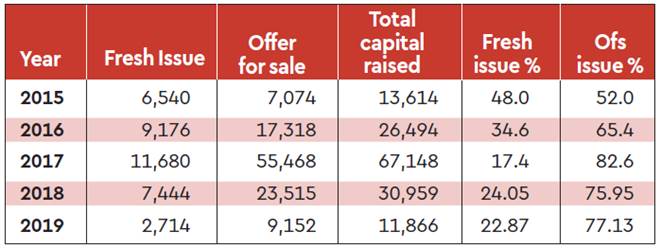By Urvashi Valecha
Companies tapping the markets are not raising as much growth capital as they used to do a few years ago. Over the last five years, there has been a gradual increase in the offer for sale (OFS) component of initial public offerings (IPOs), as there are numerous sources of capital available to emerging companies.
In the ’90s and early 2000s, IPOs were a means to raise growth capital, and consequently, companies would primarily offer fresh capital. An offer for sale is where shareholders or promoters directly sell their own equity shares in the primary market.
As capital markets mature, companies are able to raise growth capital from private equity and venture capital funds. Therefore, IPOs are now providing exits to early-stage investors through the OFS route. The share of fresh issuance has steadily been coming down over the last five years. Data from Prime Database show that Rs. 11,865.61 crore was raised till date in 2019, of which 77.13% or Rs. 9,151 crore was through the OFS route, which is close to the share of OFS in IPOs last year. In comparison, only 52% of the capital that was raised was via the OFS route in 2015.

Pranav Haldea, managing director, Prime Database, told FE that the OFS component has increased because private equity investors exit at the time of IPOs. “The low fresh capital or growth capital phenomenon is a worrying one as it shows a lack of confidence among promoters and companies regarding growth prospects,” he said. However, this shift also points to a maturing capital market. There has been a gradual increase in the OFS component in IPOs throughout the years, but not without exceptions. Prince Pipes, a company that manufactures polymer pipes, has tapped the market with an equal split for an OFS and fresh issue through its IPO that is underway.
Gaurav Sood, co-head, equity capital markets, ICICI Securities, said asset-light businesses are increasingly entering the market. “IPOs from companies with an asset-light business model have found strong appetite among investors. These companies belong to sectors like insurance, asset management, technology, EPC and healthcare where there is no ongoing requirement of capital or normal business activities.” Companies that need lesser assets for their daily operations are called asset-light companies.
Financial companies regularly tap the capital market for growth capital. In 2019, companies such as Axis Bank raised Rs. 12,500 crore to fund growth while Bajaj Finance raised around Rs. 8,500 crore through qualified institutional placement (QIP) of shares. SBI and RBL Bank have also tapped the market to raise funds through QIPs.
Experts say there has been a slowdown in raising growth capital due to limited capital expenditure in the economy. The capital market is now moving towards a scenario where companies are first finding funds through other sources such as NBFCs, venture capitalists and other private equity investors.
“They are sophisticated investors who bring in a lot of value-add for the company in its early years as they have seen similar business models globally. They have a higher IRR expectation and therefore commensurate risk appetite than traditional public market funds,” Sood of ICICI Securities explained.

